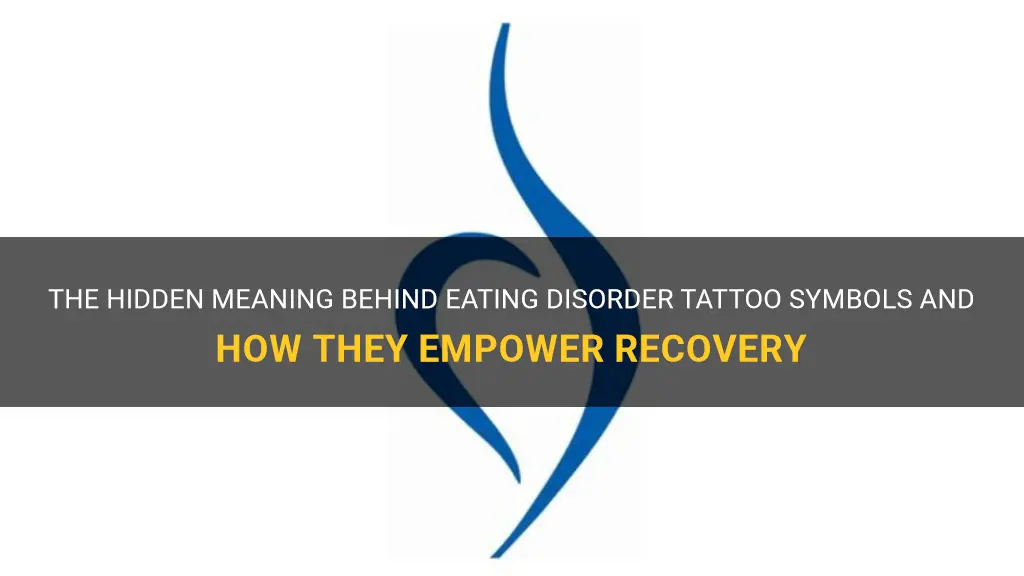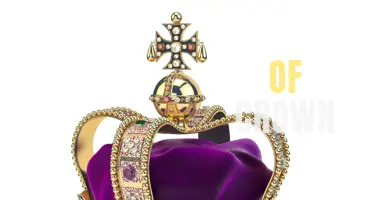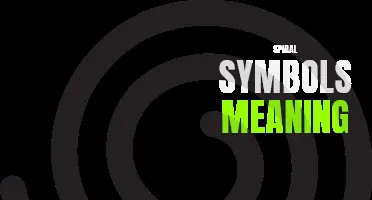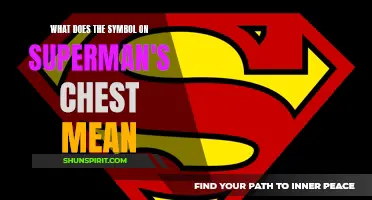
Eating disorder is a serious and complex mental health condition that affects individuals around the world. To raise awareness and promote solidarity with those struggling with these disorders, many people have turned to tattoos as a symbol of support and understanding. These tattoos often incorporate powerful and meaningful imagery that not only represents the journey of recovery but also serves as a reminder of the strength and resilience of those who battle with eating disorders. In this article, we will explore different tattoo symbols associated with eating disorders and delve into their profound meanings.
What You'll Learn
- What is the most common tattoo symbol used to represent eating disorders?
- Are there different tattoo symbols that represent specific types of eating disorders?
- What is the meaning behind the tattoo symbol for eating disorders?
- Are there specific colors or designs that are commonly used in eating disorder tattoos?
- Are there any cultural or historical references associated with eating disorder tattoo symbols?

What is the most common tattoo symbol used to represent eating disorders?
There are many symbols commonly used in tattoos to represent eating disorders, but perhaps the most common symbol is the butterfly. The butterfly has long been associated with transformation and growth, making it a fitting symbol for those struggling with eating disorders.
The butterfly begins its life as a caterpillar, which then undergoes a metamorphosis to become a beautiful butterfly. This process symbolizes the journey that individuals with eating disorders often go through as they strive for recovery and healing. Like the caterpillar transforming into a butterfly, those with eating disorders seek to transform their lives and emerge from their struggles with a renewed sense of self and purpose.
The butterfly tattoo is often depicted with colorful wings, representing the vibrant life that awaits those who recover from their eating disorder. It may also be accompanied by other symbols, such as flowers or hearts, to further convey concepts of beauty, self-love, and growth.
Another common tattoo symbol for eating disorders is the semi-colon. The semi-colon has become a widely recognized symbol for mental health and represents the continuation of life, even in the face of struggles. For those with eating disorders, the semi-colon tattoo can serve as a reminder that their story is not over and that they have the strength to keep fighting and recovering.
Some individuals may also choose to incorporate the recovery symbol into their eating disorder tattoo. This symbol is made up of three interconnected loops that represent the three stages of recovery: healing, self-discovery, and growth. It is a powerful symbol that reminds individuals of their ongoing journey towards recovery and serves as a reminder of the strength and resilience it takes to overcome an eating disorder.
Ultimately, the choice of tattoo symbol for representing eating disorders is a personal one. Different individuals may resonate with different symbols and may choose to incorporate additional elements or personal touches into their tattoo design. Regardless of the symbol chosen, these tattoos can serve as a powerful reminder of the journey towards recovery and the strength and determination it takes to overcome an eating disorder.
Decoding the Hidden Meanings Behind Hollywood's Most Iconic Symbols
You may want to see also

Are there different tattoo symbols that represent specific types of eating disorders?
Tattoos have long been used to express oneself and showcase personal beliefs, struggles, and experiences. For individuals suffering from eating disorders, tattoos can serve as a powerful means of self-expression and a reminder of their journey towards recovery. While there may not be specific tattoo symbols exclusively associated with particular types of eating disorders, there are meaningful imagery and symbols that can be incorporated into tattoos to represent the overall struggle with these disorders.
Eating disorders, such as anorexia nervosa, bulimia nervosa, and binge eating disorder, are complex mental illnesses that affect the way a person thinks about food, their body image, and their relationship with themselves. Tattoo symbolism related to eating disorders often revolves around self-acceptance, healing, and empowerment.
One common tattoo symbol associated with eating disorders is the semicolon. The semicolon tattoo is widely recognized as a symbol of mental health awareness, representing hope, resilience, and the continuation of life. Many individuals with eating disorders have found solace in this symbol, as it represents their ongoing battle with their mental health and their determination to keep going.
Another popular tattoo symbol associated with eating disorders is the butterfly. Butterflies are often seen as symbols of transformation, growth, and freedom. For individuals recovering from eating disorders, getting a butterfly tattoo can be representative of their journey towards positive change and personal growth. These tattoos serve as a reminder that their struggles do not define them and that they have the ability to transform their lives.
Feathers are also commonly incorporated into tattoos symbolizing eating disorders. Feathers represent lightness, hope, and grace. For someone battling an eating disorder, a feather tattoo can represent their aspiration to let go of the heaviness of their disorder and embrace a healthier and more balanced lifestyle.
Lotus flowers are another tattoo symbol associated with eating disorders. The lotus flower represents rebirth, purity, and inner strength. This symbol can be particularly poignant for individuals in recovery, as they strive to let go of their past struggles and emerge as a stronger and more resilient version of themselves.
Ultimately, the choice of tattoo symbol associated with eating disorders is deeply personal and varies from person to person. Some individuals may opt for a specific symbol related to their type of eating disorder, while others may choose more general symbols representing the overall struggle with their mental health. It is important to remember that each tattoo carries its own meaning and significance for the person wearing it.
If you or someone you know is struggling with an eating disorder, it is important to seek professional help from a healthcare provider or therapist. Tattoos can be a powerful form of self-expression, but they should not replace professional treatment for such a complex mental health issue. Together with professional support, tattoos can serve as a visual reminder of the ongoing journey towards recovery and self-acceptance.
The Rich Symbolism and Deep Meanings of Hmong Symbols
You may want to see also

What is the meaning behind the tattoo symbol for eating disorders?
The tattoo symbol for eating disorders is a meaningful and powerful image that represents the struggles and triumphs faced by individuals with eating disorders. This symbol is often used as a form of support and empowerment for those who have overcome their disorder or are still battling it.
The tattoo symbol for eating disorders typically consists of a butterfly and a semicolon. The butterfly represents transformation, growth, and hope, while the semicolon represents the continuation of life and the choice to keep going. Together, these symbols convey a message of perseverance and the ability to overcome challenges.
The butterfly is a common symbol for eating disorders because it represents the process of metamorphosis. Just as a caterpillar transforms into a beautiful butterfly, individuals with eating disorders can undergo a similar journey of growth and self-discovery. This symbol serves as a reminder that recovery is possible and that there is beauty in overcoming the difficulties associated with these disorders.
The semicolon is a symbol of mental health and suicide prevention. It is used to represent the choice to continue living and to remind individuals that their story is not yet over. This symbol has gained popularity in recent years as a way to raise awareness about mental health issues and to provide support for those struggling. When combined with the butterfly, it conveys a powerful message about the resilience and strength of individuals with eating disorders.
The tattoo symbol for eating disorders is often chosen by individuals who have either overcome their disorder or are in the process of recovery. It serves as a reminder of their progress and serves as a source of motivation and inspiration during difficult times. This symbol can also be a way for individuals to raise awareness about eating disorders and to start important conversations about mental health.
It is important to note that getting a tattoo symbol for eating disorders is a personal choice, and it may not be appropriate for everyone. Some individuals may prefer to find other ways to express their experiences and emotions related to their eating disorder. It is crucial to prioritize mental health and consult a healthcare professional or therapist for support and guidance during the recovery process.
In conclusion, the tattoo symbol for eating disorders is a powerful and meaningful image that represents the journey of recovery and transformation. It combines the symbolism of a butterfly and a semicolon to convey a message of hope, resilience, and the choice to keep going. This symbol serves as a reminder that individuals with eating disorders are not alone and that there is support available. It can also be a way to raise awareness about eating disorders and start important conversations about mental health.
The Fascinating Meanings Behind Symbols on Shoes
You may want to see also

Are there specific colors or designs that are commonly used in eating disorder tattoos?
Eating disorder tattoos are a form of body art that many people use to raise awareness about eating disorders and show support for recovery. These tattoos can come in various shapes, sizes, and colors, depending on personal preferences. However, there are certain designs and colors that are commonly used in eating disorder tattoos.
When it comes to designs, some popular choices for eating disorder tattoos include ribbons, hearts, butterflies, and semicolons. These designs often symbolize hope, strength, and perseverance, which are essential in the recovery process. The ribbon design is commonly associated with awareness campaigns for various causes, and many people choose a ribbon tattoo with colors representing different eating disorders, such as purple for bulimia, blue for anorexia, and green for binge eating disorder.
Hearts are another commonly used design in eating disorder tattoos as they represent self-love, acceptance, and compassion. Butterflies often symbolize transformation, growth, and freedom, which are important aspects of recovery from an eating disorder. The semicolon design has gained popularity in the mental health community as it represents a continuation instead of an end. It symbolizes the idea that one's story is not over, and there is hope for the future.
When it comes to colors, purple, blue, and green are widely used in eating disorder tattoos as they represent specific eating disorders. Purple is commonly associated with bulimia, as it symbolizes awareness and compassion. Blue is often used to represent anorexia, symbolizing awareness, understanding, and support. Green is frequently chosen to represent binge eating disorder, symbolizing growth, renewal, and energy. These colors can be incorporated into the design itself or used as a highlight or outline.
In addition to these designs and colors, individuals may choose to customize their eating disorder tattoos by adding personal touches such as quotes, meaningful words, or symbols that hold significance in their recovery journey. Some people also opt for tattoos that depict the stages of recovery or depict body positivity and self-acceptance.
It is important to note that everyone's experience with an eating disorder is unique, and individuals may choose different designs and colors based on their personal preferences and experiences. There is no right or wrong design or color for an eating disorder tattoo. The purpose of these tattoos is to raise awareness, promote support, and serve as a reminder of strength and resilience in the face of adversity.
If you are considering getting an eating disorder tattoo, it is advisable to consult with a professional tattoo artist who has experience in creating meaningful and symbolic designs. They can guide you in selecting the appropriate colors and help bring your vision to life. Remember, an eating disorder tattoo is a personal choice, and it should reflect your journey and recovery in a way that holds meaning for you.
Exploring the Symbolic Meaning Behind Pigeons: What Do They Represent?
You may want to see also

Are there any cultural or historical references associated with eating disorder tattoo symbols?
Tattoos have been a form of self-expression for thousands of years and have historically been used to symbolize a variety of meanings and beliefs. While there are many symbols associated with different cultures and historical references, there are no specific cultural or historical references directly associated with eating disorder tattoo symbols.
Eating disorders are complex mental health conditions characterized by abnormal eating habits and a negative body image. They can affect people of all genders, ages, and backgrounds. While tattoos can be a way for individuals to raise awareness or express their personal experiences, it is important to approach the topic of eating disorders with sensitivity and understanding.
Some individuals may choose to get a tattoo symbol that represents their personal journey of healing and recovery from an eating disorder. These tattoos often focus on themes of self-love, acceptance, and empowerment. Common tattoo symbols associated with eating disorder recovery include butterflies, lotus flowers, hearts, and quotes.
Butterflies are often used as a symbol of transformation and growth, representing the journey from struggle to recovery. Lotus flowers are associated with purity and rebirth, symbolizing the ability to rise above challenges and find inner strength. Hearts can represent self-love and compassion, reminding individuals to prioritize their own well-being. Quotes or words may be chosen to embody personal mantras or reminders of perseverance and positivity.
It is important to note that getting a tattoo related to an eating disorder is a personal choice, and not everyone with an eating disorder may choose to do so. Some individuals may find other forms of self-expression or coping mechanisms, such as therapy, support groups, or creative outlets, to be more helpful in their recovery journey.
If you or someone you know is struggling with an eating disorder, it is crucial to seek professional help from a qualified healthcare provider. Eating disorders are serious mental health conditions that require treatment and support, and a tattoo should not be seen as a substitute for proper care.
In conclusion, while there are no specific cultural or historical references associated with eating disorder tattoo symbols, individuals may choose to get tattoos that symbolize their personal journey of healing and recovery. These tattoo symbols often focus on themes of self-love, acceptance, and empowerment. It is important to approach the topic of eating disorders with sensitivity and understanding, and to prioritize professional help and support in the recovery process.
The Hidden Meaning Behind the Black Widow Symbol: Unveiling the Intriguing Metaphors
You may want to see also
Frequently asked questions
The eating disorder tattoo symbol typically represents hope, recovery, and solidarity for those who have struggled with or are currently battling an eating disorder. It serves as a reminder of strength and resilience in the face of adversity.
The semi-colon in the eating disorder tattoo symbol is often incorporated to represent mental health awareness. It signifies that the individual's story is not over and that they are choosing to continue fighting and living their life despite their struggles.
The eating disorder tattoo symbol is important because it helps raise awareness about the prevalence of eating disorders and promotes support and understanding for those who have been affected by them. It can also serve as a conversation starter, allowing individuals to share their own experiences and provide support to one another.
Yes, anyone can get an eating disorder tattoo symbol if they feel a personal connection to the cause or want to show their support for those who have been affected by eating disorders. It is important to approach the symbol with respect and understanding, and to not appropriate or trivialize the experiences of those who have struggled with eating disorders.







